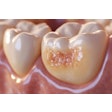
All-ceramic materials are firmly entrenched in prosthodontics, but until recently there was a gap in the research documenting their performance.
Now a new study in the Journal of the American Dental Association has established that after 10 years, three-unit fixed dental prostheses (FDPs) made from monolithic lithium disilicate have survival rates similar to metal-ceramic FDPs and better rates than other all-ceramic materials (March 2012, Vol. 143:3, p. 234-240). Previous long-term studies ended after a five-year examination period.
"In our study, FDPs made of the current version of pressable lithium disilicate glass-ceramic showed better five-year survival and success rates than did FDPs made from other all-ceramic materials, including zirconia ceramic, as shown by systematic reviews published thus far," wrote the researchers, from the Christian-Albrechts University School of Dentistry.
The latter have survival rates of 87% to 89% after 10 years, and the researchers wanted to see if all-ceramic FDPs could compete in a prospective study. They found that they measured up well, with an 88% survival rate. Chipping rates -- 3% after five years and 6% after 10 years -- were also similar to metal-ceramic FDP rates, but were smaller than previous reports on all-ceramic FDPs, which listed a 10% chipping rate after three years and a 14% to 16% chipping rate after five years.
"We recommend monolithic lithium disilicate ceramic for crowns in all intraoral regions as our study also shows that the abutment crowns made from this material withstand the loading conditions even in the molar region," said Matthias Kern, DDS, PhD, the study's lead researcher and professor and chair of the department of prosthodontics at the university.
High-stress tests
For the study, which began in 1999, faculty dentists inserted 36 IPS e.max Press (Ivoclar Vivadent) FDPs in 28 patients without any cantilever pontics (average age: 47). Patients were also screened for active periodontal disease and had to have good oral hygiene with minimal caries activity.
To test the material in a high-stress area, the researchers replaced molars in the posterior area, although the manufacturer recommends the use of lithium disilicate ceramic only for the replacement of anterior teeth and premolars, they noted.
Technicians at the university's dental department fabricated the FDPs using the lost-wax technique. Twenty-four FDPs were used to replace molars, six to replace premolars, and six to replace anterior teeth. The researchers performed a baseline evaluation one to three weeks after the procedure, and follow-up recalls took place after six and 12 months and then annually.
They used Kaplan-Meier analyses to calculate the cumulative survival and success rates. To qualify as a success, an FDP had to remain unchanged and free of complications, according to the study authors.
100% survival rate
Two patients passed away during the observation period; the rest attended all of the recall sessions. Five-year recalls were performed for 33 FDPs; an eight-year recall for 30 of them; and the 10-year recall examined 29 FDPs. Four failures, three of which were technical and one biological, and 11 complications, nine of which were technical and two biological, took place in 15 FDPs. All of the catastrophic failures took place in FDPs replacing molars, which the researchers note is an indication not recommended by the manufacturer.
"The survival rate was 100% after five years and 91% after 10 years if we considered only losses caused by catastrophic ceramic fractures (which amounted to three)," the researchers wrote.
That rate fell to 88% at the 10-year mark if all four losses were taken into account, they noted. In addition, if chipping that did not affect function was included, the rates of success were 94% after five years and 85% after 10 years. If all technical and biological complications are included, the rates fall to 91% and 70%, respectively.
The researchers were impressed by the figures that only included catastrophic ceramic fractures.
"This clinical outcome is considerably better than that in a five-year report by Marquardt and Strub involving the use of the predecessor material IPS Empress 2; the investigators reported a 30% failure rate for anterior and premolar FDPs," they wrote.
Improved materials may have played a role, but the researchers in the other study did not strictly adhere to the manufacturer's recommendations, they added.
"As shown in our study, crowns and three-unit FDPs made from monolithic lithium disilicate ceramic present a safe alternative to metal ceramic crowns or FDPs, under the condition that the recommended dimensions of the restorations are followed," Dr. Kern concluded. "Depending on the preference of the practicing dentist conventional cementation or adhesive cementation techniques can be used equally."
This study will extend to 15 years and more, Dr. Kern noted.



















